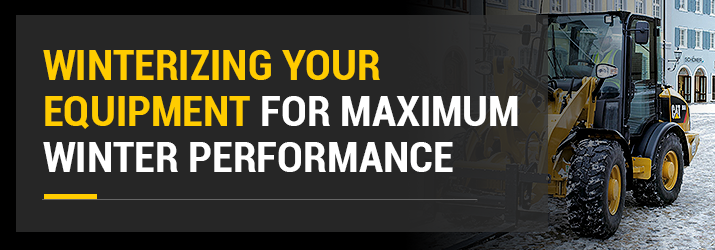
Winter temperatures get cold in Indiana and Michigan, making it important to ensure that your shop is heated and insulated properly to beat the cold. Beyond winterizing your shop, the equipment you use to drive your business during warmer months must also be safeguarded from the coldness of winter.
Jump to Sections:
- How to Winterize Equipment
- Winter Fuel Grade
- Winter Oil Changes
- Change Filters
- Equipment Batteries
- Check Coolant Types & Levels
- Check Hydraulic Fluids
- How To Store Equipment
- Why Use Block Heaters
- Engine Warm-up Period
- DEF Usage During The Winter
- Purchase Winterization Kits
As winter takes hold, the machines you place in your shop, equipment yard, or other storage area could end up damaged. If snow piles up on a machine, for instance, it could freeze the internal fluids and reduce the performance of the battery.
It’s essential to carefully prepare your equipment that will be exposed to cold conditions to prevent lasting damage. Certain equipment parts need to be kept at warmer temperatures throughout the year, and storing them in a shed or garage won’t necessarily guarantee warmth during winter.

How to Winterize Equipment
To prepare equipment for winter, you need to give routine inspections of the machines in question. If dirt or flaws are present during an inspection, on-the-spot maintenance might be necessary. To ensure that each machine remains in good shape all through the winter months, perform the following steps immediately before and after each spell of cold weather:
- Inspect each light
- Inspect the windshield wipers
- Inspect the fluid levels
- Inspect the functionality of the heater
- Lubricate the engine parts
- Inspect the body for wear and dents
- Inspect the glass and mirrors
- Inspect the brakes
- Grease the joints and hinges
Precautionary inspections and any necessary maintenance should be performed in the following areas to winterize heavy equipment.
1. Change to Winter Fuel Grade
Throughout spring, summer and fall, Cat® equipment is generally filled with Number 2 diesel (2–D) fuel. This grade of fuel can harden if the weather gets too cold. If moisture is present, icy bits can form within the fuel supply of a machine. To prevent this from happening, equipment should be filled with a Number 1 diesel (1–D) fuel during cold and snowy months.
Alternately, you could opt for a combination of 1–D and 2–D fuel to prevent it from gelling up inside the engines of your equipment.
Additionally, the following items should be completed to winterize the fuel in your equipment:
- Top off the fuel tank daily before nightfall to reduce moisture buildup in the tank.
- Empty out the water separator each day to keep the interior of the equipment water-free.
- Make sure the fuel rating is at least 40 Centane on normal winter days and at least 50 Centane during sub-zero temperatures.
At the end of each winter, empty out the tank with the engine running to purge the tank of stale fuel.
2. Change the Engine Oil
Seasonal oil changes are a basic part of equipment maintenance, regardless of temperatures. Oil flows better in warmer conditions, so it’s best to switch to a synthetic base multi-grade oil in the wintertime if temperatures drop below -22 degrees Fahrenheit.

3. Inspect the Engine
If you need to use a piece of motorized equipment during the winter, always run the engine first for a few minutes. This gives the engine a chance to warm up to the same level that it would normally be under regular spring, summer and fall temperatures. The low number of rotations per minute during the warm-up phase makes things easier on the intake and exhaust valves.
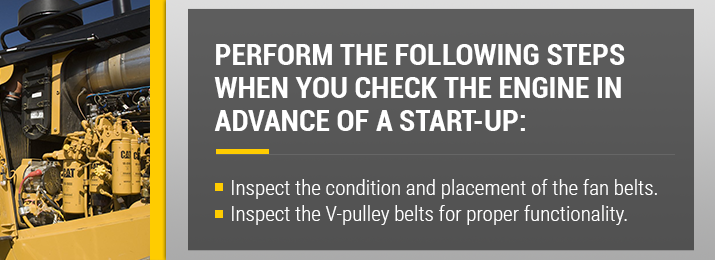
To help prevent unexpected engine problems in a machine after months of hibernation, perform the following steps when you check the engine in advance of a start-up:
- Inspect the condition and placement of the fan belts.
- Inspect the V-pulley belts for proper functionality.
4. Change the Fuel, Hydraulic and Oil Filters
The change-out of filters is just as important to the health of an engine as the change-out of oil. When you change the oil from regular-weather 2-D to wintertime 1-D, also check the fuel filters to see whether they’re clean or need to be replaced.
Clogged filters are hard on the engine. Always have replacement filters on hand in case you need to make a quick change-out. Also be sure to empty out the water trap for the fuel before the freeze of winter takes hold.
5. Keep the Battery at Room Temperature
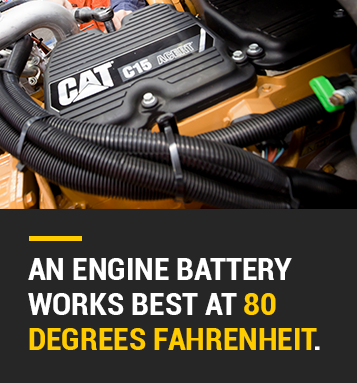 Fuel and oil are what make an engine operate, but without a healthy battery, an engine won’t come to life at all. During winter, the battery is actually the most vulnerable of all the engine components to freezing temperatures.
Fuel and oil are what make an engine operate, but without a healthy battery, an engine won’t come to life at all. During winter, the battery is actually the most vulnerable of all the engine components to freezing temperatures.
An engine battery works best at 80 degrees Fahrenheit. When the temperature drops below that point, the battery becomes less efficient. At 32 degrees Fahrenheit, a battery loses 65 percent of its cranking capacity. This in turn increases the pressure on your engine by more than 50 percent during start-up.
If the battery temperature drops to -20 degrees Fahrenheit, the battery retains only 18 percent of its cranking ability while the pressure on the engine will nearly triple at start-up.
No battery lasts forever, but the quality of a battery is defined by its power and life expectancy. To keep the battery preserved for its intended lifespan, perform the following steps during winter:
- Store the battery in a warm, moisture-free environment.
- Charge the battery in advance of placing it in storage.
- Recharge the battery any time it falls under 75 percent of its full capacity.
- Inspect the battery for traces of dirt, rust or moisture. Any of these can kill a battery early.
- If you store the battery for more than 10 days, unplug its ground cables.
- Store batteries in a vertical position. Don’t stack batteries horizontally.
If you keep the battery stored all winter long, check on its condition every four to six weeks. Due to their sensitive nature, batteries need a bit more cold weather maintenance care than other engine components.
6. Adjust the Coolant
As you check the engine with the motor running, inspect the coolant for bubbles. Coolant should always be free of impurities and rise an inch above the core of the radiator. Look for a grade of coolant with a freezing point that can handle the expected coldness in your area.
If the coolant in your engine needs to be replaced, choose the best grade for your machine and region from the Cat line of coolants. Cat coolants are formulated to work in extreme temperatures and last three times as long as other brands. Cat coolants are also made with organic additives, which make the fluid more powerful and offer corrosion resistance.
Balance the Antifreeze and Water
For a machine to perform optimally in colder weather, the antifreeze mix must be properly blended. To prevent the coolant from freezing in sub-zero temperatures, use a 50/50 mix of antifreeze and water. In less severe cold you can use a higher percentage of water. Try not to use water with traces of sand, grit or heavy minerals.
7. Inspect the Conveyor
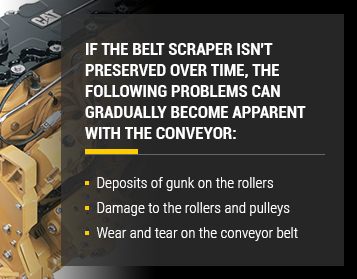 If the belt scraper isn’t preserved over time, the following problems can gradually become apparent with the conveyor:
If the belt scraper isn’t preserved over time, the following problems can gradually become apparent with the conveyor:
- Deposits of gunk on the rollers
- Damage to the rollers and pulleys
- Wear and tear on the conveyor belt
The belt can also become misaligned due to a poorly-maintained scraper. Therefore, the surface condition and tension quality of the belt scraper should be checked each season.
When the weather gets cold, it’s important to make sure the conveyor rubber doesn’t stick to the belt. A belt is liable to fail if it contracts during freezing temperatures. If the belt gets buried under snow for any length of time, its performance will degrade considerably. To be on the safe side, the belt and any other detachable parts should be stored in a warmer place when not in use during winter.
8. Check the Hydraulics
Hydraulic fluids should be inspected and replenished right before the winter season. If oil drips from the dipstick when you pull it out for an inspection, the fluid level is fine. Make sure the suction filter and chamber are also properly lubricated.
Be certain you only use hydraulic fluids that are made to handle the operating temperature of your machine. A mismatched fluid will lead to early hydraulic failure. Cat hydraulic fluids are formulated to boost the performance and engine life of motorized equipment. Made with organic properties, Cat hydraulic fluids are tested and optimized to offer consistent performance in all types of temperatures.
As you check the hydraulic fluid, also inspect the condition of the hoses. When temperatures get cold, a hydraulic hose is liable to crack if the wrapper swells. To keep the hose in better condition, run the engine to bring the hydraulic oil up to 150 degrees Fahrenheit and keep it running at this temperature for 60 minutes. In preparation for sub-zero temperatures, use arctic hydraulic oil.
9. Inspect the Tires
The tires on any machine should be given a daily once-over during wintertime. When the weather gets cold, tires have more trouble holding air inside. If possible, inflate tires in a warm setting to boost the bead seal. To prevent the formation of ice crystals — which can cause your tires to deflate — fill your tires with dry nitrogen gas.

10. Perform Visual Inspections
Each time you approach your machine, do a quick walk-around to inspect its parts. Take a look at the hoses, belts, tires and electrical wires in advance of each use. Do you see any cracks or signs of wear? As you carry out the inspection, wipe away any dirt, dust, moisture or snow that might have accumulated since the last time you checked.
11. Inspect the Undercarriage
In advance of the winter season, have an inspection of the undercarriage performed to ensure that all the parts are working properly. Any issues that could potentially be compounded by ice and snow should be eliminated before the cold begins. If a machine has been buried up in snow for any length of time, have the equipment inspected by a professional before you resume operations.
12. Inspect the Hoses
To ensure optimal performance from the hoses, test them with a firm hand squeeze. Does the rubber feel like that of any normal hose or does it seem to be in a soft or brittle state?
If a hose feels soft, it’s probably had contact with lubricants, which is bad for the rubber. A hose in this state is likely to rupture under high pressure. Alternately, if a hose feels brittle, it’s possibly been subjected to intense levels of heat. A brittle hose may crack if subjected to further heat. In either case, the hose should be replaced before use of the machine resumes.
When you replace a brittle, overheated hose, consider routing the new hose differently within the engine. This way, you could possibly spare the new hose from overheating like the old one. Whichever way you route it, just make sure the new hose doesn’t rub against other components within the engine.
13. Check the Fan Belts
As you check the engine components, inspect the tension and alignment of the fan belts. One problem that frequently arises with equipment owners is improper belt tension. An under-tensioned belt is liable to slip, while an over-tensioned belt can also be problematic.
When you check the fan belts, keep the engine running at full capacity. Once a few minutes have passed, turn off the engine and feel the belts. If the rubber is hot, there’s a problem with the tension. If one belt needs to be replaced, replace all the belts at the same time to keep things consistent.
14. Store Equipment Properly
It’s important to store your motorized equipment in an enclosed facility during winter. This helps protect your equipment from the elements when wintery conditions intensify. It’s also best to store fluids in a location where ideal room temperatures — somewhere between 40 degrees and 60 degrees Fahrenheit — can be consistently maintained around the clock.

If the equipment will not even be put to use between late fall and early spring, separate any detachable parts and store them individually. This helps prevent damage or rust along the joints and hinges.
15. Use Block Heaters
One of the easiest ways to get an engine started up in colder temperatures is with the use of a block heater. A block heater can speed up the process of warming the engine and hydraulic fluid. To make the process even more efficient, block the radiator as you warm the engine. This will restrict the fan air and allow the machine to come to life quickly despite the cold temperatures.
16. Use Starting Fluid
Another way to get equipment started up quickly in the colder months is with the use of starting fluid. As with all fluids, starting fluid should be stored at room temperature. However, due to the flammability of starting fluid, such products should be stored in a safe place, separate from the operator’s compartment. Only remove the fluid from storage when the time comes to start the machine.
17. Run the Engine Before Operation
Whenever you use a piece of motorized equipment in cold weather, it’s crucial to run the engine first. The engine must be brought to its full operating temperature before you run the equipment. This helps eliminate exhaust and intake sticking and also gives your engine a chance to “wake up” fully.

It’s also a good idea to give the newly warmed machine a quick run-through of all its various functions to keep them healthy. If a piece of equipment hasn’t been used for several months, the run-through will give you a quick idea of the machine’s immediate health. You’ll also be able to tell if any repairs might eventually be needed. If any problems are apparent, this early run-through could help you stop them before they become costly.
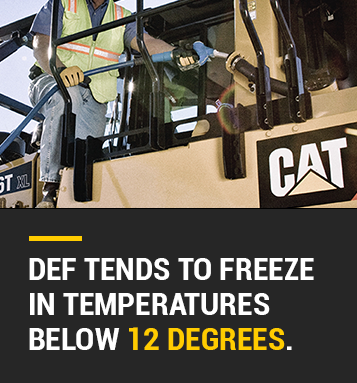
18. Store Diesel Fluid Correctly
Diesel exhaust fluid (DEF) requires careful storage regardless of grade. Even though certain grades can be more helpful to an engine in colder conditions, the contents of a DEF container can still freeze. In general, DEF tends to freeze in temperatures below 12 degrees. The best place to store DEF is in an insulated cabinet.
If a DEF container has frozen, be careful with the thawing process. As it thaws, DEF can burst if not stored in the proper type of container.
Purchase Cat Winterization Kits at MacAllister Machinery
The steps that encompass equipment winterization are among the most important things you can do for your yard equipment. From the inspection of the battery, hoses and filters to the change-out of oil, fuel and other fluids, winter maintenance for equipment helps ensure operability come springtime.
Thankfully, Cat winterization products can make the process more reliable, because Cat fluids are formulated for the challenges of cold winter temperatures.
At MacAllister Machinery, we help equipment owners winterize their machines with high-quality products. The fluids in our inventory are formulated to keep engines in good health throughout the cold months. Whether it snows or drops to sub-zero temperatures, you can keep your motorized equipment ailment-free with the help of our service and products.
Contact MacAllister Machinery to schedule service at our shop or get DIY winterization parts and products for your equipment.
